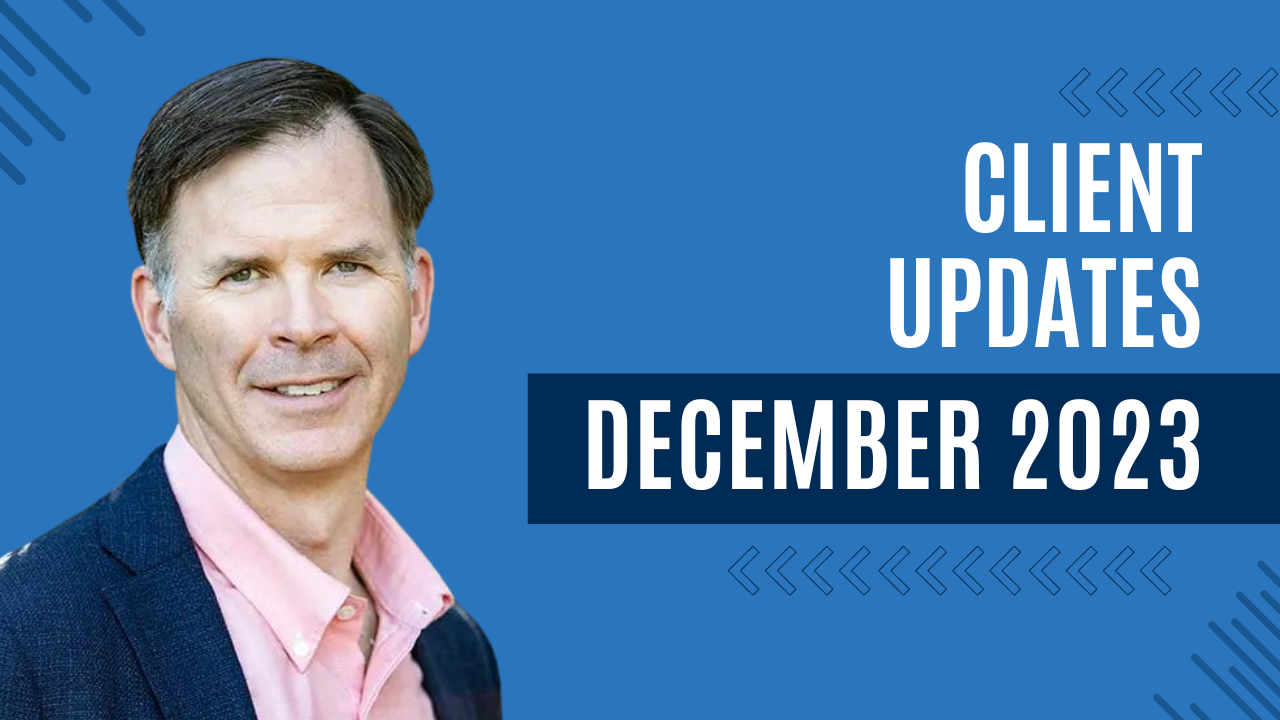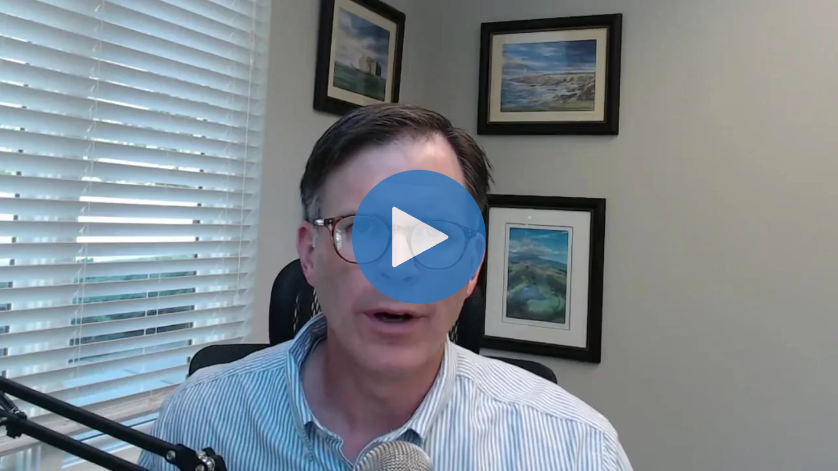How do you make your investment decisions? | Client Update February 2024
{% video_player "embed_player" overrideable=False, type='hsvideo2', hide_playlist=True, viral_sharing=False, embed_button=False, autoplay=False,...
6 min read
 Chris McAlpin
:
Dec 20, 2023 4:49:58 PM
Chris McAlpin
:
Dec 20, 2023 4:49:58 PM

Risk is both a feature and a bug of investing. That means the most critical way you can empower yourself to make smarter financial decisions (and minimize risk as much as anyone can) is through education. That’s why we take the time to do client presentations, such as this one, each month.
Particularly in times like these when there is no shortage of conflicting reports concerning headlines and confusing data points. Altogether, it’s understandably hard to understand what is happening in today’s volatile financial landscape.
🔑 Free resource: Financial planning template for individuals and families
So, in this year’s final client update — as we all look ahead to 2024 — we’re going to do our best to answer how we’re doing, how we’re looking at the facts and data, and how we make our decisions with our investment framework.
When I looked back at the Client Update we did at the start of this year, my agenda led with the following — “Everything Bubble burst.” After that, “Sea change,” referencing the major global, political, economic, and market changes we were all experiencing at the time. I closed off with the argument that while no one can predict the future, nothing beats good planning and action.
🔎 Related: How to choose a financial advisor (tips + questions to ask)
Now, if we take a look at December 2023, what do we see? The stock market has gone up, especially in the past couple of months. It begs the question, “Is the ‘Everything Bubble’ back?”
With stocks going up, bonds going up, commodities going up, currencies going up, and precious metals going up …. is the Everything Bubble back? Currently, our answer is probably not because “sea change” still exists. Just as we talked about almost a year ago, we’re seeing major global, political, economic, and market changes.
Think of the world as one large pond. The norm we’ve been used to is the United States being the big fish in this pond, primarily competing with other large fish, such as China. The tides, however, are changing.
🔎 Related: Tax savings strategies for high-income earners (+ examples)
To be clear, I’ve never claimed to be a great geopolitical fortune teller. However, there are signs we may be entering a new cold war with China, in which we divide up the world’s resources again. We’re already starting to do something called “shoring,” in which we’re bringing the production of a lot of manufactured goods — e.g., pharmaceuticals, refinement of commodities (agriculture or energy) — from overseas back to the United States
This is something we saw starting with the COVID-19 pandemic in 2020. And we’ll likely see the wheels continue to turn in this direction for the next 25 years or so, as competition increases.
Currently, the United States is 2122% of the world’s GDP, with China not far behind with 2021%. Along with our allies, however, we collectively make up 55% of the world’s GDP. China and their allies, on the other hand, make up about 25% — that means we’ll continue to see competition over that remaining 20% in South America, Africa, and the Middle East.
Laid against the backdrop of conflicting global political views (e.g., a potential withdrawal from NATO, if Trump is re-elected vs. President Biden leaning into NATO), we need to look at these facts outside of the context of politics. Instead, we must acknowledge conflicting global political views agnostically, as moves on either side create “sea change.”
It’s also essential to remember that in the United States, we are agriculturally independent, energy independent, financially independent, and militarily independent. The military piece is an important one to remember when we talk about “sea change” in today’s climate.
🔎 Related: Asset vs. wealth management (What’s the difference?)
For instance, the Suez Canal is threatening to be shut down due to pirates and Iranian-backed terrorists, which, in turn, disrupts supply chains throughout the world. The United States is one of the largest naval patrols in the world, charged with two responsibilities — we keep those sea lanes safe, and we also control them.
When we say “sea change,” what I’ve shared here is a snapshot of what we’re discussing. We’re in the midst of major global and political events that are entirely unpredictable. These events affect the global economy, which affects market changes.
When we look at our investment framework, which governs how we make decisions, you’ll see there are four pieces to it:
However, it’s important to note when we talk about expectations in these four areas — for instance, we’ll likely see monetary policy and market trends move into neutral positions by the end of this year — we’re not making forecasts. What we do instead is look at market valuations to try and determine where expected future returns might be.
That’s what you’ll see in this presentation. When we look at the data across those four areas, we do not have a lot of confidence to go diving into a large number of U.S. stocks. We think there are other opportunities elsewhere.
🔎 Related: Is the stock market gambling?
Additionally, when we look at the business cycle data, we see a yield curve that is inverted. This is worth noting, as eight of the last nine times an inverted yield curve happened, we went into a recession. And with bad economic data coming out in the first two quarters of next year, we believe we will have a recession in the first six months of next year.
Now, will the headlines say we’re in a recession? Will those who measure the economy declare we are in a recession? I have no idea — particularly since we’ll be in an election year, and declaring a recession is a major political event.
But what politicians and pundits do (or do not) decide to declare doesn’t change the fact that the economy is slowing. That’s what the numbers are telling us and have been telling us for 18 months.
For instance, think of where interest rates are. Yes, there are tons of buyers out there who are looking for a home to call their own. Unfortunately, many people don’t want to sell if they were able to snag a low interest rate (e.g., 2.75%, 3.5%, 4.25% on a 30-year mortgage). Who can blame them? Who would want to sell a house at such a low rate, to go and get a 7% or more interest rate on a new home?
🔎 Related: How much does investment management cost?
Another critical data point to look at is the fact that people are still spending money. And what we’re seeing is that folks are moving from spending out of their savings account to credit cards, with debt now increasing. This is one of the telltale signs of the end of an expanding economy and the start of a recession.
One blessing we’ve seen is that unemployment numbers are still the best they’ve been in two generations, which has helped keep our economy strong. We’d love to see this stay the same.
In the last couple of months, we’ve seen bonds going up; we feel like we’ve seen the bottom of the bond market, so we’re starting to see a genuine recovery. We’ve also seen stocks going up. However, international stocks are where we believe the biggest opportunities are in the future.
There are, of course, points we should note. Lumber is ahead of gold, which is a negative. Copper is ahead of gold, which is a negative in the markets. Now, high yields are ahead of treasuries, which is a positive thing. Stocks are ahead of gold, which is a reversal (and a positive). Stocks are also over bonds, which is a positive for growth assets.
🔎 Related: Real assets vs. financial assets (comparison + examples)
What we’re trying to do is measure growth assets that are giving us the greatest return — stable assets and conservative assets.It’s important to note here we are using trader-like measurements, but we are not using them to trade. We are using them to measure market direction and to make slow changes over time.
In our opinion, the Federal Reserve’s strict monetary policy is overly aggressive, as they have significantly decelerated the economy, which is what they wanted to do, with 18 months of leading economic indicators that are negative. Eventually, the economy is going to hit a wall and slow down. As noted earlier, we think that that's going to be early next year and that by the second half, we'll be in a recovery.
Again, we are not making forecasts, but when we look at the totality of our investment framework, we believe there are better opportunities in bonds, not stocks. We believe there are better opportunities in international stocks rather than U.S. stocks.
We believe we should be diverse and broad in our portfolio based on this investment framework. This is how we look at the world to arrive at these beliefs. So, our decisions are not based on our gut instinct or us guessing what direction we think markets are going to go — or what direction we want them to go.
That’s why I appreciate the trust you put in us. We don't just listen to the Bloomberg radio on the way into the office in the morning and try to make a decision. There's a lot of thought and research and investment that goes into the framework.

{% video_player "embed_player" overrideable=False, type='hsvideo2', hide_playlist=True, viral_sharing=False, embed_button=False, autoplay=False,...

{% video_player "embed_player" overrideable=False, type='hsvideo2', hide_playlist=True, viral_sharing=False, embed_button=False, autoplay=False,...

Client Update: February 2022 Sound February 2022 Client Update There is so much data announced this week that it is hard to find a...